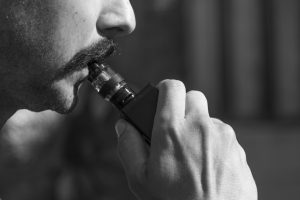In 2011, just seven million people around the world vaped. By 2016, that number had reached 35 million and continues to grow. If you are interested in vaping, there’s some terminology you need to understand first.
Some of the most important are PG and VG.
Do you know the difference in PG vs VG? Are those initials somewhat familiar, but you aren’t exactly sure what they are or what they mean?
If so, don’t worry–you aren’t alone. However, if you plan on vaping, it’s a good idea to learn about these initials sooner, rather than later. These two things will impact your vaping experience significantly.
E-liquid Ingredients
Table of Contents
Premium e-liquids contain four main ingredients (keep in mind, each e-liquid contains different ingredients):
- Food-grade flavorings
- Water
- Nicotine
- A PG or VG base
The base, also called the carrier, holds the flavor and nicotine in suspension so your entire vaporizer or e-cigarette can product the nice clouds of the smoke-like vapor.
Both vegetable glycerin and propylene glycol (VG and PG) are non-toxic organic components and are considered safe for consumption by the FDA. These are widely used as food additives in many commercially available personal care and food products.
For example, ketchup includes propylene glycol.
Keep reading to learn more about PG and VG and which is right for your vaping experience.
PG E-Liquid
The first option is PG-based e-liquid. Some important qualities of this e-liquid include:
Thinner Consistency
PG e-liquid has a thinner consistency. This makes it easy to absorb by the cotton fabric and polyfill inside cartomizers and the wick tanks.
Less Gunk
Because of the low density of the juice, the gunk doesn’t become built-up on the vaporizer’s heating element. This is a problem that occurs with the thicker vegetable glycerin liquid.
No Effect the Flavor
PG is tasteless and odorless. This means it doesn’t affect the e-liquid in any way.
Stronger Throat Hit
PG is a humectant. While it may cause your throat and mouth to dry out if used regularly, it also offers a throat hit that is stronger and more similar to a tobacco cigarette.
Allergy Risk
One disadvantage of PG is that it has caused allergic reactions in the past. These vary from minor reactions to more serious irritations to certain parts of the body. If you experience this, it’s best to switch to VG based e-liquids.
VG E-liquid
Are you interested in creating large billowing stacks of vapor? If so, then choosing VG is a better option. Some specific qualities of VG liquid include:
Thicker
VG is a much thicker solution than PG. It has a much slower absorption rate for cartomizers and wicks.
More Gunk
Because of the thick consistency, VG causes gunk that can clog up the vaporizer. This means you have to clean it more often.
Sweeter
Alone, VG has a slightly sweeter taste. This makes the e-liquid sweeter and the flavors more difficult to detect.
More Vapor
One reason VG is so beneficial is that it helps to produce more vapor and doesn’t cause allergic reactions. If you want to try cloud chasing, then VG is right for you.
PG vs VG: What’s Right for You?
The choice of PG vs VG is one that comes down to personal preference. Many people opt for PG because the vegetable glycerin distorts the flavor. However, VG offers thicker clouds than PG. The choice is up to you.
Check back often to find out more about vaping and other information you may find helpful.
Latest trends and developments in vaping as of 2024 would involve highlighting the following key aspects:
- Market Growth and Consumer Preferences: The vaping community has continued to expand, with an increasing variety of products and flavors. There’s a noticeable preference for both traditional and adventurous flavors, as well as a growing interest in ‘functional’ e-liquids that include added health benefits. This trend is indicative of a more health-conscious vaping audience.
- Technological Advancements: Vaping technology has seen significant advancements. Popular products include user-friendly disposables with higher puff counts and adjustable features, as well as compact all-in-one systems. Customizable devices are also on the rise, allowing users to tailor their vaping experience to their personal preferences.
- Sustainability and Environmental Concerns: The industry is increasingly focusing on sustainability, with efforts towards creating recyclable vapes and components. There are initiatives to reduce environmental impact through tree-planting campaigns and the introduction of eco-friendly, biodegradable products.
- Health and Safety Updates: Ongoing research continues to shed light on the health effects of vaping. Updated safety guidelines address concerns like the appropriate nicotine content in e-liquids and safer manufacturing standards for devices. The health debate around vaping remains active, with new studies contributing to a more nuanced understanding of its impacts.
- Legal and Regulatory Changes: The vaping landscape is being shaped by regulatory changes. This includes a move towards alternatives aimed at helping users quit vaping, such as nicotine-free vapes and products like SNUS and nicotine pouches. These changes reflect a broader societal focus on health and well-being.

